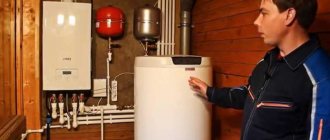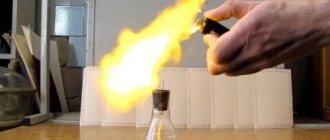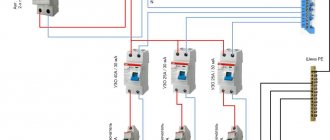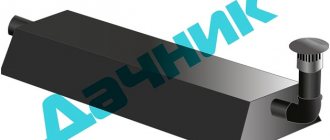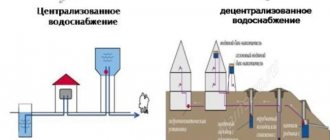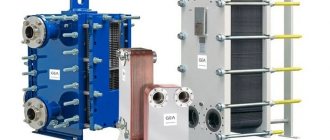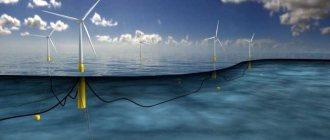- Operation of a double-circuit gas boiler with a flow-through heater
Such heating devices have become widespread. Due to their small size, excellent power characteristics and ease of maintenance, they are increasingly used for heating. In addition, the cost of gas is now much lower than alternative fuel sources. The design allows you to simultaneously heat the living space and heat water, which eliminates the need to purchase a water heater separately. If you decide to install such equipment, you should find out all the nuances of the installation and find out how a double-circuit gas boiler works.
How does a device serve two circuits work?
This heat generator, when compared with the single-circuit version, is equipped with two heat exchangers. According to established technical terminology, they are called primary and secondary. One is located in the fire burning zone itself. It is used to heat the fluid for the system. The second is responsible for the functioning of the hot water supply. And that's just the basics.
The unit consists of numerous interconnected units that perform various actions. There is no need to disassemble it thoroughly. It is enough to understand that only well-coordinated interaction can guarantee long-term and problem-free use, and to know about the most important elements.
To understand what a double-circuit gas boiler is, you should examine in detail the structure of its main components.
Types of burners
These devices heat water and generate heat for heating. When fuel is burned, energy is produced. The device is located in a compartment into which gas and air are pumped to ensure the combustion process.
Classification by operating modes:
- Single-level. Units equipped with such devices can only operate in two positions: “start” and “stop”. They are not economical and quickly break down, but are popular due to their simplicity of design and low cost.
- Two-level. Generators equipped with elements of this type can operate at both full and half power. This feature is a tangible advantage, since there is no need to use the device at full capacity in the summer.
- Modulated. The smart boiler system allows you to customize and regulate the intensity. These units are characterized by efficiency and a very long service life.
Burners can be open or closed. In the first option, oxygen comes from the room in which the heating apparatus is installed. To prevent combustion waste from entering the living area, a chimney is used to provide exhaust.
Atmospheric heat generators are equipped with a metal pipe. The smoke duct is usually mounted in a vertical position or at an angle.
Turbocharged variations are equipped with closed chambers. They are considered very reliable, but they are complex in functionality and are expensive. In addition to the smoke exhaust, a channel is needed through which oxygen enters the chamber. Therefore, units of this type are equipped with coaxial pipes, since they need not only to remove smoke, but also to draw in air.
All models contain fans, protective systems and automation. The generators listed above require electricity to operate. Energy dependence, due to which operating costs increase significantly, is their main disadvantage.
Types of heat exchangers
These devices receive heat and transfer it to the wearer. The primary is located above the burner and has the shape of a finned, curved serpentine tube. Under the influence of fire, the temperature of the liquid rises and begins to move towards the heating distribution.
The secondary consists of plates and two pairs of pipes. Water flows through one of them, the other is intended for the movement of coolant along the heating circuit. Such a system is called dual.
In addition, there are generators with a bithermal heat exchange mechanism made from copper. This is a pair of pipes located one above the other. The carrier is redirected along the outer one, and the solution for hot water supply is redirected through the inner one. Such units are difficult to operate; due to their configuration, it is not easy to clean them from contamination. Accordingly, you need to know how to properly use a double-circuit boiler. But thanks to their mobility and high heating rate, they are in good demand.
Automation and control unit
The automatically operating mechanism ensures stable and safe operation. Controls the water temperature in the water supply system of the heat exchanger. In emergency situations, it prevents the heating device from operating.
It stops turning on if:
- gas pressure has decreased;
- suddenly no traction;
- overheating has occurred.
The ECU coordinates protection and process automation devices. Consists of several switches, microcircuits and their combinations.
Intelligent control is a hallmark of modern generators with different operating characteristics.
Prices: summary table
| Model | Efficiency, % | Max gas consumption, m3/hour | DHW capacity, l/min at t 30°C | Cost, rub. |
| BAXI ECO-4s 24F | 92,9 | 2,73 | 9.8 at t 35°C | 43 200-47 500 |
| Vaillant turboFIT VUW 242/5-2 | 93,5 | 2,66 | 11 | 45 000-53 200 |
| Viessmann Vitopend 100-W A1JB010 | 91 | 2,77 | 11,2 | 54 000-61 000 |
| Bosch Gaz 6000 W WBN 6000-24 C | 93,2 | 2,8 | 11,4 | 39 800-42 000 |
| Buderus Logamax U072-24K | 92 | 2,8 | 11,4 | 43 500-52 500 |
| Ariston ALTEAS X 24 FF NG | 93,7 | 2,73 | 9.6 at t 35°C | 64 200-69 000 |
In what modes can it function?
Or how a wall-mounted double-circuit gas boiler works in summer and winter. Its activities are carried out in two variations:
- Winter. All systems of the unit are activated - the coolant is heated, heated water is prepared according to the parameters.
- Summer. During the hot season, the heating circuit is switched off, only DHW heating is active.
The decision to change the position (when to turn it off and on) is made by the user; this is an elementary action that does not require the presence of a specialist. The supply of boiling water is necessary constantly, because of this the perimeter of the water supply operates uninterruptedly. If the need arises, you can turn it off.
There is another mode - protective. It prevents freezing when the temperature drops sharply to the set level. In critical situations, increased circulation is started, the pump begins to circulate the liquid at high speed, preventing it from freezing. For Russian regions this is very important, given the climatic conditions. Thawed pipes are a common problem.
Distinctive features of heat exchangers
The heat exchange unit of the heating device can be cast iron, steel or copper. The cast iron version retains heat for a long time, is almost not subject to corrosion due to the high wall thickness and is resistant to aggressive coolants. It is heavy and therefore mainly integrated into floor-standing boilers.
Requires great care during installation, since any impacts violate the structural integrity of the material and lead to the formation of microcracks.
The steel structure weighs little, is not afraid of mechanical stress, can easily withstand temperature changes in the coolant, and is easily transported and installed. Has some tendency to corrosion. The boiler control system helps to avoid it, which prevents the coolant temperature from falling below the critical point.
Copper elements are an order of magnitude more expensive than their cast iron and steel counterparts, but they compensate for the substantial cost with a large number of advantages. Inside the copper heat exchanger, sediment and scale are formed to a minimum and do not interfere with the normal circulation of the working fluid. The walls of the device are heated evenly and do not cause local overheating of the coolant.
Basics and specifics of operation
Few people think about the diagrams and operating principles of a wall-mounted double-circuit gas heating boiler. The heating circuit and water do not heat up at the same time. The unit operates in normal mode only to heat the contents moving through the system. The frequency of switching on and the intensity of the fire is controlled by a temperature sensor. At the same time as the burner, the circulation pump starts, if natural movement is not provided for in the process.
When the temperature rises to a certain level, the meter transmits a signal indicating a decrease in the activity of the heat generator. Until it drops again to a predetermined value, the device remains inactive.
Which is better - convection or condensation?
First of all, it is necessary to understand the difference between the operation of one and another unit.:
- Convection - works on the usual principle of heat transfer. The coolant is heated due to the thermal energy released during fuel combustion.
- Condensing is a boiler that produces two-stage heating of the coolant. First, the OM receives a certain amount of thermal energy from the condensation of water vapor, which is contained in the exhaust combustion products. The partially heated coolant then enters the primary heat exchanger and is finally heated in the usual way.
The advantage of condensing boilers is the ability to reduce fuel consumption and, accordingly, reduce the heating intensity of the heat exchanger. Since the liquid has already received some heat, the burner operating mode can be reduced.
All this together allows you to increase the service life of the boiler components and parts and increase its efficiency. The efficiency of condensing boilers, declared by all manufacturers, is 107-109%, although in this case the usual marketing ploy takes place.
Such efficiency cannot exist by definition, but this is not the main problem . Condensing boilers are able to demonstrate proper efficiency only in low-temperature systems, where the degree of return heating is lower than the condensate temperature.
This is only possible if the difference between external and internal temperatures does not exceed 20°, which is simply impossible in Russian realities.
Therefore, you can choose a condensing boiler only in southern regions with warm winters.
NOTE!
The price of a condensing boiler is almost twice the cost of convection models of the same power. If operating conditions do not allow you to obtain the expected effect, you should refuse to purchase a condensing model.
Diagram of operation of a device serving two circuits
It is not possible to use a dual-circuit device to simultaneously heat the room and water supply. As soon as the water tap is activated, the movement of the coolant through the heating mechanism stops.
If the heated liquid is used for household purposes in too large quantities, the possibility of interruption in the operation of the boiler in terms of heating cannot be ruled out. There are two ways to get out of this situation: install a more powerful unit or add a boiler to the complex.
If DHW is used intensively, it would be optimal to install a device with a built-in heating device. Fuel consumption will, of course, increase, but not by much. This is explained by the fact that in the intervals between functional cycles the burner ensures that the temperature of the water in the additional water heater is maintained.
The reserves located in the built-in boiler make it possible to use water without turning off the heating circuit, which allows you to obtain the required temperature at the right time, automatically providing a sufficient amount.
Operation of a double-circuit gas boiler with a flow-through heater
In this case, a plate heat exchanger is used, which is characterized by high efficiency but low productivity. It passes two flows in a perpendicular direction between metal plates, which are aligned in such a way that the flows do not mix. The large area provides good heat transfer, which allows you to heat water in the process (on the go).
With a compact size, the design increases the temperature level to 50° and even higher, which is typical only for highly efficient units.
As disadvantages, it should be noted the unstable heating mode and mandatory regular cleaning of limescale.
Operating principle of a double-circuit gas boiler with a biothermal heat exchanger
This device is in the form of a coil, presented in the form of a coaxial pipe. Simply put, two pipelines inserted into each other. The coolant moves through the external volume, and the liquid for hot water supply moves through the internal volume. This heating method significantly changes the quality characteristics of the work. The supply of hot water increases and efficiency increases, which is perfect for meeting the needs of a large family.
A noticeable disadvantage of such a heat exchanger is the complexity of its structure, which makes flushing difficult.
You should not forget to promptly remove lime deposits that quickly accumulate on the surface of the pipe. Otherwise, the section will be completely blocked. In addition, the thicker the plaque layer, the lower the heating activity. Accumulated contaminants turn into a heat insulator. When adjusting the operation of the heating device, you have to constantly increase the fuel supply. Under such conditions, the device very soon fails. This is facilitated by internal scale and systematic overheating.
Not all service centers undertake to flush the unit. In some particularly difficult situations, it is easier to change the generator than to fix it. The disadvantages of biothermal structures are mainly due to improper operation. If we consider this installation in terms of productivity, it is quite suitable for use.
Reviews of domestic wall-mounted models with a DHW circuit: advantages and disadvantages
| Advantages | Flaws |
| Favorable price - double-circuit models are only 10-15% more expensive than single-circuit models, so this is the cheapest way to organize hot water supply in the house, compared to installing a gas water heater, electric boiler, etc. | Higher probability of failure - double-circuit models can operate without problems for 10 years or more, but statistically the probability of failure is higher compared to single-circuit ones, due to their more complex design and additional features. nodes |
| Compactness - double-circuit boilers only in rare cases differ in size from the same single-circuit analogues from the same manufacturer | Relatively long delay in the supply of hot water - can be solved by more expensive models with a built-in boiler |
| Simplicity of connection - a minimum of communications connected to one point, in contrast to the installation of separate devices for heating water | Limitation in productivity - on average, the DHW productivity of common modern models is within 8-12 l/min, which is enough for a maximum of three, and according to owner reviews, often only for two points of simultaneous consumption |
| Availability of relatively inexpensive models with a built-in storage tank, solving problems of comfort and, to some extent, performance | Energy dependence - all heating gas wall-mounted double-circuit boilers require connection to the electrical network, despite high demand, non-volatile models do not exist due to the specific design |
| Restrictions on the use of antifreeze - most models are not designed to use antifreeze as a coolant, and only some manufacturers allow the use of a certain brand of liquid, as indicated in the operating instructions |
Classification
The answer to the question of how a double-circuit gas boiler works varies depending on its type. According to the installation method, devices are divided into:
- Wall-mounted. These are small-sized devices of moderate and low power. As a rule, they are installed in small houses.
- Floor-standing. They are massive, so their location requires more space. Despite the dimensional inconveniences, such units can simultaneously support the activity of hot water supply and warm up a large area of the room.
According to the layout:
- Atmospheric. They are placed next to the chimney, taking air from the room in which the device is installed. Window openings and good ventilation are required.
- Turbocharged. The operation of this boiler is independent of draft, since combustion waste is removed by a fan powered by electricity.
Functional division:
- Single-circuit. Heating work.
- Dual-circuit. Equipped with 2 radiators. Maintain the operation of the heating system and fill the taps with hot water.
By type of burner:
- Simulated. Features automatic flame control.
- Regular. Complete lack of independent regulation.
By type of ignition:
- Piezo ignition. The unit is turned on by pressing a button and changing the position of the piezoelectric element. Characterized by energy independence. Among the shortcomings it is worth noting: impressive fuel consumption, the need for manual action.
- Electronic. The built-in transformer, controlled by automation, is triggered.
According to the principle of operation:
- Convection. In this standard design, heat is transferred to water during combustion.
- Condensation. The temperature of the water vapor is involved.
Types of ignition function
A household double-circuit boiler is started manually (using matches or a lighter) or using built-in elements (electric ignition or piezo ignition). The first method is the simplest and most accessible. The second makes it possible to save blue fuel by not leaving the wick in the igniter to burn constantly.
There is only one disadvantage of this option - dependence on the availability of electricity in the network. If for some reason the power stops flowing, the equipment immediately turns off and is automatically activated again when the electrical supply is restored.
Piezo ignition is absolutely safe and allows you to turn on the boiler by pressing just one button. The element does not depend on the supply of current and you can use the equipment even in the absence of electricity.
Installation Features
Installation of this type of equipment is a very responsible matter. To ensure its proper functioning and your own safety, you must approach this issue with the utmost care. First of all, you should pay attention to the following points:
- The place where it is planned to install the boiler must comply with all regulatory parameters. It is necessary to coordinate its location in advance with representatives of the gas service.
- The connection project is initially drawn up on paper and then sent for approval to the appropriate organization.
- After receiving permission, its employees will personally install the necessary metering devices to monitor fuel consumption.
- Before starting installation, you need to make sure that the unit is fully equipped. If some parts are missing, such a device cannot be installed. This may lead to an emergency situation.
- First of all, installation points are determined on the wall surfaces, only then do they begin the phased installation of all elements.
- Upon completion of the installation activities, the system is connected in series. Test filling the circuit with water, then heat the boiler.
- If you find any problems or smell gas, you should not try to fix the problem yourself. In such cases, you should immediately call a specialist who will assess the condition of the structure on the spot and carry out the necessary repair work.
Boiler power
One of the key points in choosing a heating boiler is determining the required power. If we approach this with full responsibility, it is necessary to consider the heat loss of each room, if we are talking about an apartment or a building as a whole, if the boiler is selected for heating a private house. The calculations take into account the materials of the walls, their thickness, the area of windows and doors, the degree of their insulation, the presence/absence of an unheated room below/above, the type of roof and roofing material. Geographical location and a whole bunch of other factors are taken into account.
Such a calculation can be ordered from a specialized organization (at least in GorGaz or a design bureau), if desired, you can do it yourself, or you can take the path of least resistance - calculate based on average standards.
Where does the heat leave the house?
Based on the results of all calculations, a standard was derived: heating 10 square meters of area requires 1 kW of heating power. This standard is suitable for rooms with ceilings of 2.5 m, with walls with an average degree of thermal insulation. If your room falls into this category, divide the total area that needs to be heated by 10. You get the required boiler power. Then you can make adjustments - increase or decrease the resulting figure depending on real conditions. It is necessary to increase the power of the heating boiler in the following cases:
- The walls are made of material with high thermal conductivity and are not insulated. Brick and concrete fall into this category for sure, the rest - depending on the circumstances. If you are choosing a boiler for an apartment, you need to add power if the apartment is corner. For “internal” ones, heat loss through them is not so terrible.
- The windows have a large area and do not provide airtightness (old wooden frames).
- If the ceilings in the room are higher than 2.7 m.
- If in a private house the attic is not heated and poorly insulated.
- If the apartment is on the first or last floor.
The design power is reduced if the walls, roof, and floor are well insulated and energy-saving double-glazed windows are installed on the windows. The resulting figure will be the required boiler power. When searching for a suitable model, make sure that the maximum power of the unit is not less than your figure.
Where can I buy
Having figured out the design of a double-circuit wall-mounted gas boiler, you should think about purchasing it. Additionally, you will need a chimney kit.
Among those that have proven themselves in this market, one can note one of the largest manufacturers of chimneys in Russia - Industrial. Thanks to the latest metalworking tools and a careful approach to the selection of raw materials, it produces only high-quality products.
The undeniable advantages of FERRUM chimneys:
- They are not inferior in quality to European analogues, but cost 2 times less.
- Suitable for any heating devices.
- They are easy to install.
- Manufactured from stainless, heat-resistant steel.
- Average service life is 20 years.
You can get all the necessary information and find out prices for chimneys by calling the phone number listed on the official website of PC Ferrum.
Types of ignition methods and which method is the most optimal?
There are two types - electric ignition and piezo ignition. The first option is used on volatile boilers and occurs automatically after setting the desired coolant temperature.
Piezo ignition is a method used on non-volatile units. The specifics of such a launch are much more complicated and require a certain procedure.
Electric ignition is much simpler, faster and more reliable, but in the absence of electricity, you have to use the available options.
The most top manufacturing companies
- Vaillant is a German concern that produces equipment almost all over the world;
- Buderus is another German manufacturer that produces energy-efficient and functional models;
- Baxi is an Italian company that produces classic, high-quality models;
- Protherm is a Slovak company whose products are popular due to their affordable prices;
- Lemax is a domestic leader that produces not only domestic boilers, but also water heaters.
Combined models
A high percentage of efficiency, the ability to independently monitor and control the combustion process - this is the advantage of combined models. They work not only with wood - you can also use gas.
#1
Combination boiler Kiturami KRM 30R 35 kW double-circuit
Convenience and simplicity: what else do you need?
This unit has 2 chambers: for solid fuel and for liquid fuel. Among the functions it is especially pleasant to see: protection against excessive heating of the device, light notification about turning on and off, automatic ignition.
The package includes a remote control and a thermostat (it can be installed in the room to control the temperature).
Mains voltage is single-phase. The heat exchanger is made of high quality steel. The box is installed on the floor.
Specifications:
- warranty period: 24 months;
- weight: 170 kg;
- dimensions: 855x1360x700 mm;
- liquid pressure in the circuit: 2 bar;
- hot water productivity at 25°C: 10.4 liters per minute.
Advantages
- durable steel body;
- affordable price;
- heats a large room;
- ergonomic;
- comfortable;
- easy to find on sale.
Flaws
- no tank;
- no pump;
- massive.
#2
Combination boiler ACV Delta Pro S 45 44.3 kW double-circuit
Reliable, efficient, environmentally friendly.
This stylish boiler contains polyurethane (insulation) and operates on several types of fuel. The burner can be BMV1 or any other one from the market that meets the parameters.
There is a connection to the chimney, there is a kit for a closed combustion chamber. The controls are intuitive: switch, control thermostat, thermometer, “winter/summer”.
You can install an ACV control unit (a corner is allocated for it). Fuel type: diesel or gas. Boiler volume - 65 liters. The efficiency level at 80/60°C is 92.8 percent.
Specifications:
- power: 55kW;
- DHW capacity: 362l/10min (Δt 30 °C);
- weight: 168 kg;
- chimney connection (mm): 100;
- boiler heating time from 10 to 80°C, (min): 16;
- thermal power: 44.30 kW;
- parameters: 540x1615x584 millimeters.
Advantages
- several types of automation;
- decent power;
- well assembled;
- single-phase mains voltage;
- safety valve installed;
- There is protection against system overheating.
Flaws
- heavy;
- rarely found in retail;
- no expansion tank.
